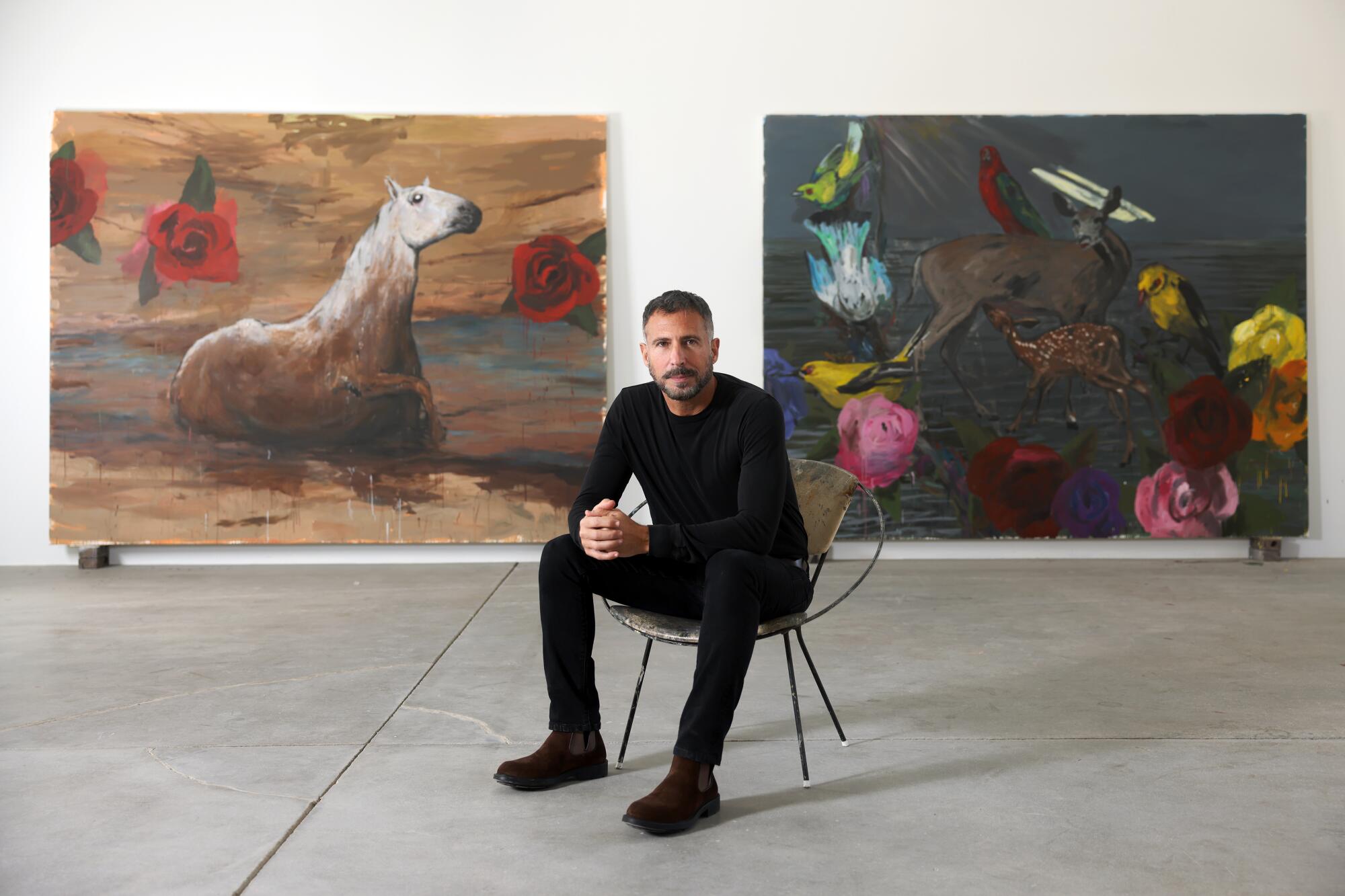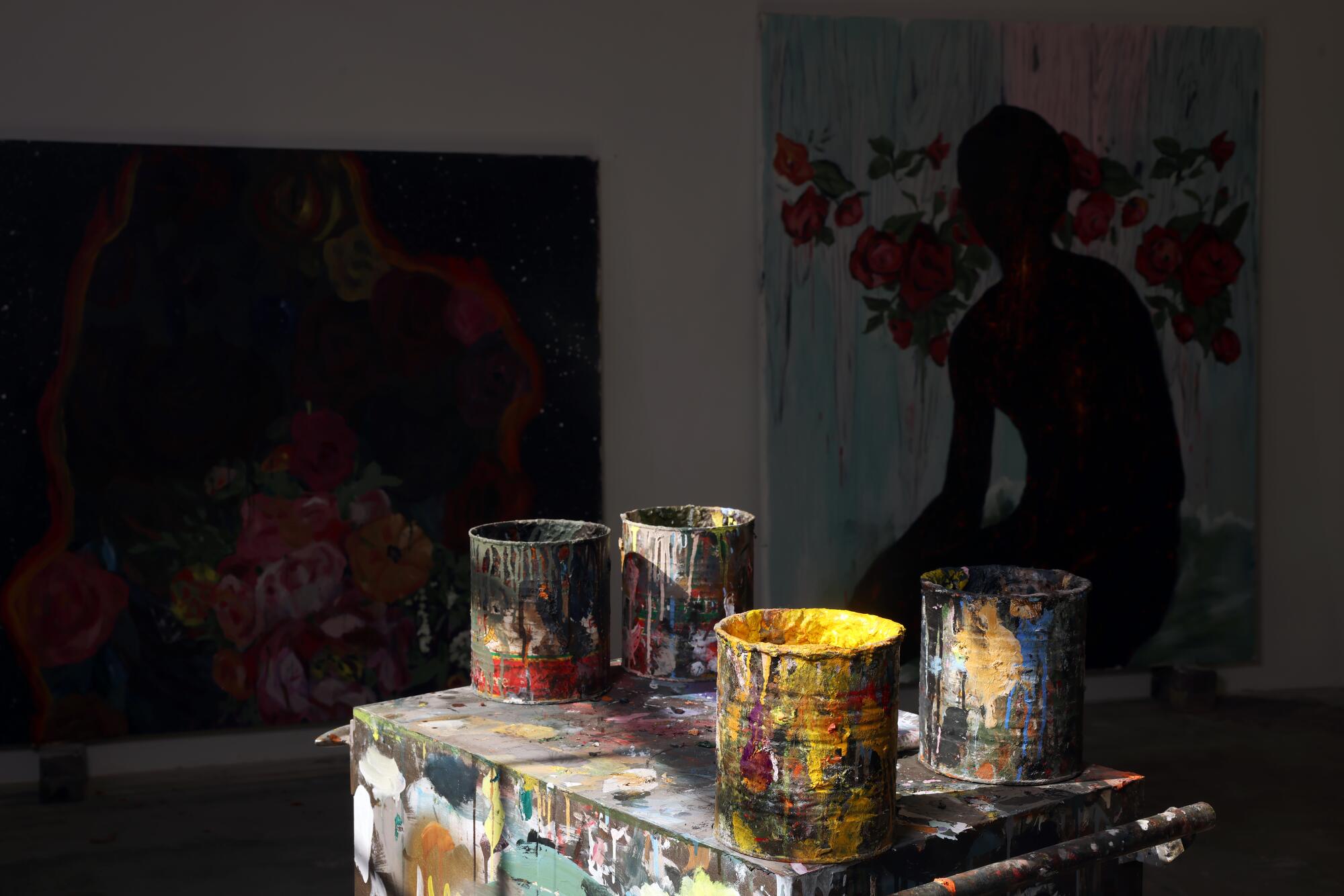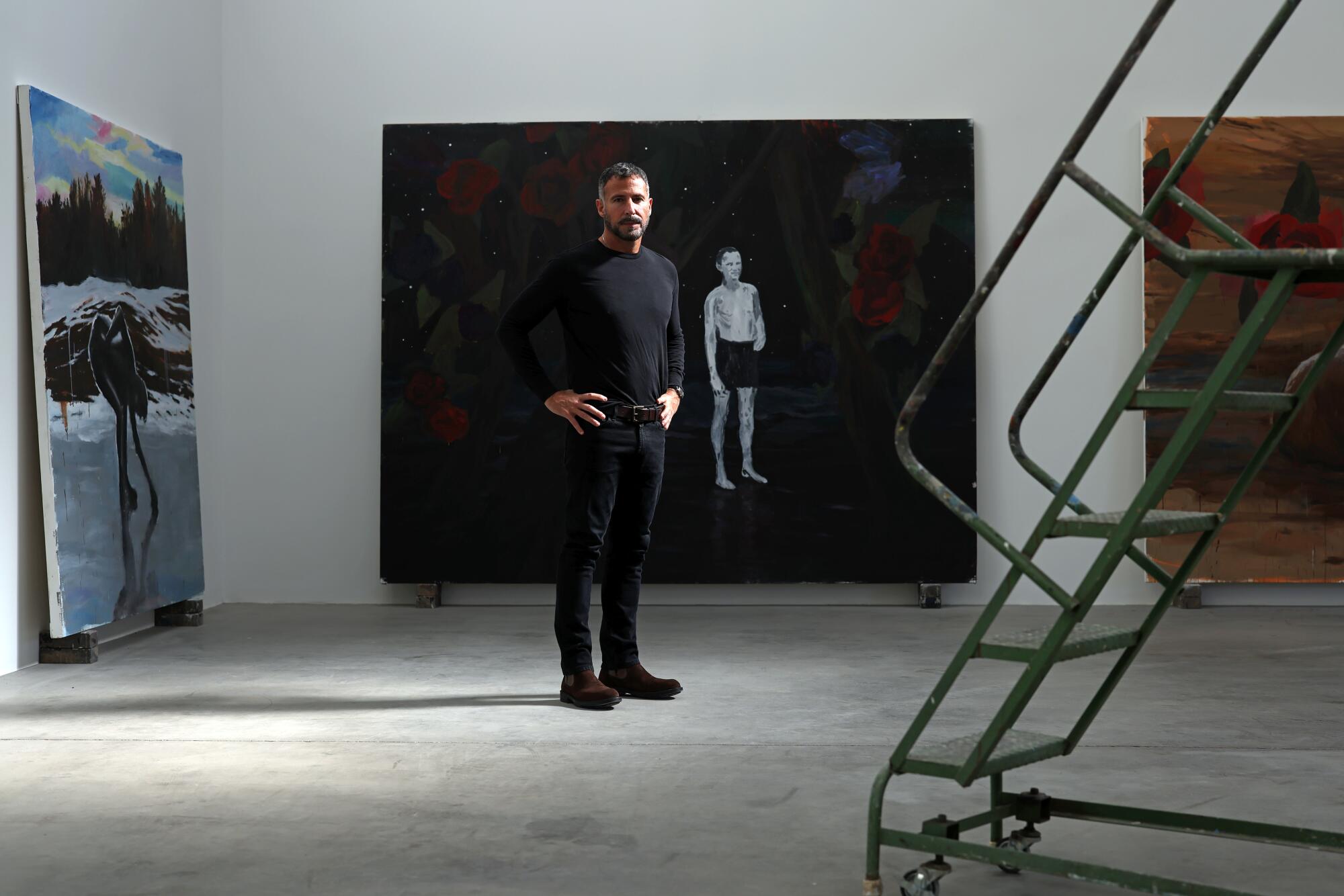
- Share via
When the artist Enrique Martínez Celaya was 9 and living with his family in a storage room in Madrid, a creditor came banging on the door. His father was away, his mother was crying.
“I puffed my chest out, opened the door to this guy and confronted him,” he recalls with a laugh. “Imagine what that man saw in front of him, just a little kid trying to be tough. When the guy went away, I felt like I’d shown him something.”
The family had moved to Spain from Cuba a few years before, in 1972, in the wake of the revolution. Exile from both his home country and formerly comfortable lifestyle registered in the young Martínez Celaya as a profound sense of difference, an estrangement that he masked with bravado. What worked that day with the bill collector landed him, he says, in frequent fights throughout his youth. “Walking around with a certain pride or bearing, a sense that nobody’s going to make me buckle, had to do with not showing the fragility and vulnerability and fear, and the chaotic quality of so many things in my life as an immigrant, living in these circumstances,” he says. “It was a shield.”
Martínez Celaya spent his teenage years in Puerto Rico, reading German philosophers and cultivating an intellectual life that further served as a form of protection from letting his true internal turmoil show. He came to the U.S. to study science, and not until the late stages of his doctoral research in physics did he turn fully to art, which he had shown serious interest in since childhood.
Now 57, and long based in Los Angeles, Martínez Celaya works across media — painting, sculpture, photography, writing — driven by questions about his place in the world, memory’s role as the formative stuff of identity, the notion of home as an elusive sanctuary and more. Often he situates a single figure, usually a child, within a vast, frozen landscape or beside the turbulent sea. He stages scenes of emotional intimacy, resonant with loss and yearning, frequently on a scale so large that viewers are immersed, body first.

In addition to an impressive international exhibition record, Martínez Celaya has also amassed a wide-ranging slew of honors and projects that reflect the practical integration of all his fields of interest, the underlying truth that they are all one field. He has been a guest on “On Being,” the public radio show “about the big questions of meaning.” He has collaborated with the Berliner Philharmonie as well as the Cowboy Junkies. A provost professor of humanities and arts at USC (the first to hold that position), he teaches across the disciplines of art, philosophy and literature, this semester leading a seminar on the Western Sublime. The post is similar to one he held previously at Dartmouth, as a Roth Distinguished Visiting Scholar.
He is the first artist to be named a visual arts Fellow at the Huntington Library, Art Museum, and Botanical Gardens. The shelf of books featuring his art and his writings holds more than two dozen titles and widens annually. In 1998, he launched his own imprint, Whale & Star, to publish books of poetry, critical theory and art, and to provide a vehicle for educational and outreach programs. Martínez Celaya is also completing the final edits on his first novel.
This season presents a rare opportunity for those in Southern California to steep themselves in the artist’s work and thought. The USC Fisher Museum of Art recently opened his show “SEA SKY LAND: towards a map of everything,” a thematic assembly of some 30 paintings and sculptures made since 2005. Running through April 9, the show features monumental canvases as well as a suite of delicate studies on pages of Braille and sheet music, a tarred and feathered boat, suitcases stacked tall on a burnt chair and more. The installation serves, he says, as “a primer” to understanding his approach and key lines of inquiry.
A second show at USC, which opened earlier this month in the Edward L. Doheny Jr. Memorial Library, features writings, small paintings and found objects and a video that illuminates intersections between Martínez Celaya’s concerns and the life and poetry of Robinson Jeffers. An expanded version of the show (also closing April 9) will travel to the Monterey Museum of Art in May.
An installation commissioned by the Huntington opened last fall and continues at least through 2022. During Frieze week, UTA Artist Space in Beverly Hills opened “The Rose Garden,” a show of new paintings and sculpture (through March 12) that Martínez Celaya considers his most personal yet, the present endpoint of an arc that has him increasingly putting into his work “more acknowledgment of myself.”
Review: Enrique Martinez Celaya’s art of displacement and longing
On a mid-January afternoon, a dozen large canvases destined for the UTA show lined the walls of his new painting studio. The other rooms of the expansive, handsome Crenshaw district space were still under renovation, and the paintings too — depicting, among other things, a wounded bullfighter, a boy feeding swans, a blood moon hovering inside a palace and a horse struggling to free itself from mud — remained subject to change. Martínez Celaya paints in thin layers, often wiping away or covering over what he’s already defined, endowing the surfaces with their own concealed histories.
High above the paintings, near the rafters, reads the ethical credo the artist has painted on the wall of every one of his workspaces over the decades: Keep Your Actions Faithful.
“Words are the biggest influence on me,” he says. The touchstone of his most recent work, the text that has been speaking to him most urgently now, is T.S. Eliot’s long, wrenching poem, “Four Quartets.”
“When I’m not reading it, I’m listening to it, read by Jeremy Irons, and it feels like that is the ether through which everything I’m doing is happening,” he says. “There’s no reference to Eliot in any of the images, but Eliot is providing a philosophical prayer about the forces that I think are at play.
“Central to this body of work is the concern with time, the circularity of time and the battle between longing and the reality of the present,” he adds. “One of the reasons the ‘Four Quartets’ really hits me at this moment is the sense of aging that is so present in it. I’ve been feeling it, and the transience of life, how quickly it goes by.”
The new paintings and sculptures are accompanied by a photographic self-portrait showing the artist clothed only in flowers that he’s painted on his own body. Portions of Eliot’s text are written on a tall glass vitrine containing sculpted roses amid thorny stems. A charred figure of a boy sits in contemplation before a large painting of a blood moon hovering inside a flooded palace. The entire presentation is intentionally theatrical, while still characteristically sourced in private emotion.
“You’ll be inside a poem,” Martínez Celaya says. “Not just Eliot’s poem, but my own poem.”

The artist’s installation at the Huntington incorporates Eliot’s words directly and draws a connection between the interior journey alluded to by the poet (“a pilgrimage on his knees,” as Martínez Celaya puts it) and migration in a broader sense. He was one of two artists (the other is Sandy Rodriguez) commissioned to contribute work to “Borderlands,” a thematic reinstallation and recontextualization of part of the Huntington’s American art collection. Dennis Carr, Virginia Steele Scott Chief Curator of American Art, asked Martínez Celaya to reimagine the long, glass-fronted loggia of the Virginia Steele Scott Galleries, introducing some dynamism to a space that felt static.
“Enrique has done it brilliantly by painting right on the glass of the loggia, literally making the skin of the building a transparent plane that visitors can see through into the garden spaces and landscapes of the Huntington,” he says. When sunlight streams in, Carr adds, the luminosity brings to mind stained glass.
Birds have been a recurring motif in Martínez Celaya’s work, and here he has painted a variety of them in bold, unfussy strokes and gem tones across the floor-to-ceiling glass façade. Winding green arrows denote the birds’ migratory paths — which transcend geographical borders, Carr notes — and meandering red lines represent the L.A. area freeway system. A fragment of Eliot’s text, also painted on the glass, runs the length of the loggia, starting near the entrance with the words: “All time is unredeemable. What might have been and what has been point to one end, which is always present.”
The installation, titled “There-bound,” also includes two oversized birds, sculpted in high-density foam and sheathed in a lightweight, sturdy concrete. They rest on their sides, directly on the floor, their plump breasts serving as benches, their single raised wings as enveloping backrests. To perch on the forms, to be partially nested by them, is to partake of a pleasant inversion.
The view from the benches, out across native coast live oaks to the San Gabriel Mountains, summons a sense of the land’s long history, its shifting stewards and changing uses, says Carr.
“All of that was what we talked about with Enrique, and he took it to a metaphysical level, to think about how borderlands impacted him as an artist and a person. He exemplifies the peripatetic nature of life in the 20th and 21st centuries that we were hoping to bring out in the show.”
Through the painted windows, visitors can also see “The Gambler” (2010), a life-size bronze sculpture by Martínez Celaya that was recently acquired by the Huntington. The figure of a young man (modeled after the artist’s son) stands, leaning on a pair of crutches, hunching over from the weight of a house strapped to his upper back. Another of the artist’s lone souls, compromised and on the move, prompts the questions: How much of identity is locational? Is the concept of home external to us, or internal?
While birds and other figures have served as proxies in Martínez Celaya’s ongoing visual autobiography, in “The Fury,” the lone painting that hangs at the far end of the loggia, he appears overtly as himself, in his painting clothes, looking with weary intensity at the viewer. An owl above his shoulder clutches in his talons an indeterminate, blood-red mass, something that clearly belongs on the inside rather than dangling, exposed.
“The Fury” forces you out of the safe territory you are usually in when looking at a portrait, says Martínez Celaya. “The owl looks at you in the same way the figure looks at you: You are sort of implicated. Some transgression has happened there which is irreparable, and you are the one watching it happen. You are the witness.”
“Rarely in his work do you get such a deeply personal view into his psyche,” adds Carr. “It’s a difficult painting.”
Works in the Fisher Museum show also abound in references specific to Martínez Celaya’s life, but the images read more as vivid metaphors than transcribed memories. Two figures near the end of a dock in one large painting barely materialize; time and distance have rendered them figments. In another canvas, a cabin floats on a sun-reddened sea, the water doubling as lifeblood. A warm yellow glow from within promises shelter, safety, however unreachable. In a nearby sculpture, another house, this time in bronze, is provisionally lodged within a tangle of uprooted rose branches.
In the work of Enrique Martínez Celaya, the yearning, aching soul finds its form.
Selma Holo, who retired as director of the Fisher in January, acknowledges the curatorial challenge posed by an artist of Martínez Celaya’s scope.
“We can, after the fact, map the meanings of his work, but we can’t oversimplify them,” she says. “The exhibition is the narrativization of something that came about over the years.”
When Holo, a scholar of Latin American art and Spanish art and literature, first met Martínez Celaya five or six years ago, she was stunned. “Where do you ever find someone with a mind that deep, provocative, imaginative?” she recalls. “I knew that I’d be retiring, and I was thinking of my last exhibition. I wanted to do something that encapsulated what I wanted my legacy to be.”
She brought in Susan Anderson, a former student of hers and independent curator, to organize the show. “It took a while for it to mature, but it became the most important show I’ve done in my life.”
What Holo has dubbed her “last picture show” might punctuate her 40-year career, but not in the definitive manner of a period or even an exclamation point. The exhibition functions more like an ellipsis, an open-ended invitation. “Enrique touches the parts of us the world right now is trying to destroy, especially the contemplative part,” she says. “We need Enrique, his persona as much as his art. When you hang around with his art and let it enter your soul, you leave enriched. We need to know that we can be bigger and better than we are. Enrique gives us permission, and lets us know that we can be.”
“Now is Enrique’s moment,” Holo declares. And thanks in part to the serendipity of COVID-adjusted schedules, which turned sequential offerings into simultaneous ones, now is certainly L.A.’s moment to experience his work.
The projects have come to fruition at a time when Martínez Celaya says he feels more anchored than he’s ever been. But even solid ground is fertile, he says, to sprout the sort of questions that arise when taking a retrospective look at decades of work.
“There’s a double-whammy effect. The [Fisher] show is a kind of testimony to what I’ve done, with implications of accomplishment, but also implications of failure,” he says. “What was left undone? What is not here?”
At the Huntington and UTA space, he begins to answer.
More to Read
The biggest entertainment stories
Get our big stories about Hollywood, film, television, music, arts, culture and more right in your inbox as soon as they publish.
You may occasionally receive promotional content from the Los Angeles Times.











